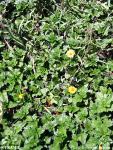1 OCAMPO R, 1988
Encuesta TRAMIL (Costa atlántica), Instituto de Desarrollo Agrario, Universidad de Costa Rica, San José, Costa Rica.
2 MARCELLE G, 1996
TRAMIL survey. Produce chemist laboratory, Ministry of Agriculture, St. George's, Grenada.
3 BENEDETTI MD, 1994
Encuesta TRAMIL. Universidad de Puerto Rico, Mayagüez, Puerto Rico.
4 WHO, 1991
Guidelines for the assessment of herbal medicines. WHO/TRM/91.4. Programme on Traditional Medicines, WHO, Geneva, Switzerland.
5 BOHLMANN F, ZIESCHE J, KING RM, ROBINSON H, 1981
Naturally occurring terpene derivatives. Part 300. Eudesmanolides and diterpenes from Wedelia trilobata and an ent-kaurenic acid derivative from Aspilia parvifolia. Phytochemistry 20(4):751-756.
6 BOHLMANN F, NGO LE VAN, 1977
Naturally occurring terpene derivatives. 97. New kaurene derivatives from Wedelia species. Phytochemistry 16:579-581.
7 CRAVEIRO AA, MATOS FJA, ALENCAR JW, MACHADO MIL, KRUSH A, SILVA MGV, 1993
Volatile constituents of two Wedelia species. J Essent Oil Res 5(4):439-441.
8 KOHEIL MA, 2000
Study of the essential oil of flower-heads of Wedelia trilobata (L.) Hitch. Al-Azhar J Pharm Sci 26:288-293.
9 CÁCERES A, GONZÁLEZ S, GIRÓN L, 1998
Demostración de la actividad antimicrobiana de plantas TRAMIL en base a los usos populares en la cuenca del Caribe. Laboratorio de productos fitofarmacéuticos Farmaya y Facultad de Ciencias Químicas y Farmacia, Universidad de San Carlos, Guatemala, Guatemala.
10 CÁCERES A, GONZÁLEZ S, GIRÓN L, 2000
Demostración de la actividad antimicrobiana de plantas TRAMIL en base a los usos populares en la cuenca del Caribe. Laboratorio de productos fitofarmacéuticos Farmaya y Facultad de Ciencias Químicas y Farmacia, Universidad de San Carlos, Guatemala, Guatemala.
11 GARCÍA GM, COTO MT, GONZÁLEZ CS, PAZOS L, 1999
Actividad bronquial del extracto acuoso de planta entera fresca de Wedelia trilobata. Informe TRAMIL. Laboratorio de Ensayos Biológicos LEBI, Escuela de Medicina, Universidad de Costa Rica, San Pedro, Costa Rica.
12 PAZOS L, COTO T, GONZÁLEZ S, QUIROS S, 2003
Tránsito intestinal, en ratones, del extracto acuoso de hojas frescas de Wedelia trilobata. Informe TRAMIL. Laboratorio de Ensayos Biológicos, Universidad de Costa Rica, San Pedro, Costa Rica.
13 GARCÍA GM, COTO MT, GONZÁLEZ CS, OCAMPO R, PAZOS L, 2001
Velocidad del tránsito intestinal en ratones, del extracto acuoso de brotes frescos de Wedelia trilobata. Informe TRAMIL. Laboratorio de Ensayos Biológicos LEBI, Escuela de Medicina, Universidad de Costa Rica, San Pedro, Costa Rica.
14 HERRERA J, 1992
Determinación de parámetros farmacológicos usados en medicina tradicional popular en la Cuenca del Caribe. Departamento de Farmacología, Facultad de Salud, Universidad del Valle, Cali, Colombia.
15 GOH CL, 1986
Contact sensitivity to Wedelia trilobata. Contact Dermatitis 14(2):126.












